|
Walsall is usually remembered as the
centre of an extensive leatherworking industry, but in
reality there was much more. It used to be known as ‘The
town of a hundred trades’, which included all kinds of
metalworking, tube making, iron and brass founding,
electrical engineering, car and motor
scooter making, chain making, lock making, and much more.
Walsall became a wealthy Black Country
town because of its many industries that flourished, thanks
to the hard-working, and skilled labour force. At the
beginning of the 19th century the principal trades in the
town were as follows:
awl blade makers
buckle makers
bradoon makers
bridle bit makers
bit makers
bone and ivory turners
brush makers
brass coach founders
bridle cutters
bridle and harness tongue makers
carpenters’ tool makers
coopers’ tool makers
curb makers
curriers
coach bit makers |
|
coach harness makers
iron founders
dog chain makers
factors
locksmiths
nail makers
platers
saddler’s ironmongers
spur makers
spur rowel makers
stirrup makers
snaffle
makers
saddle tree makers
set makers. |
|
| |
|
| In 1864 William Franklin wrote a paper about
Walsall's trades as part of a government report.
Read
his paper
|
 |
| |
|
Leather Trades
The industry started from small
beginnings in the early 19th century. The 1801 census lists
the occupations of the heads of households, and acts as a
rough guide to the number of people employed in the
industry. The following list is based on the information in
the census:
|
Trade
Bridle cutters
Coach harness makers
Curriers
Glove makers
Saddlers
Tanners
Thong makers
Whip makers
Total |
|
Number of
people employed
18
5
12
1
4
2
3
1
46 |
|
The number of people employed in the
saddlery and harness trades rapidly increased during the
19th century:
|
Census
1821
1841
1861
1881
1901 |
|
Number of
people employed
33
171
523
3,492
6,830 |
|
Before the leather trade developed in
the town, Walsall was well known as the centre of the
lorinery trade. Since the 16th century Walsall’s blacksmiths
had been producing hand-forged bits, buckles, saddle trees,
spurs, and stirrups etc. Some loriners diversified into
saddle and harness making, as a way of extending the range of their
products. It seems likely that saddle and harness making in
Walsall developed as a result.
|
|
|
| Read about Walsall's
Leather Industry |
 |
| |
|
|
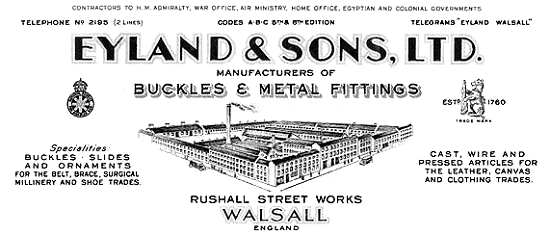
One of Walsall’s oldest
manufacturers, founded in 1760, is Eyland and Sons
Limited, originally based at Rushall Street Works,
number 11 Lower Rushall Street. The firm was established
by Moses Eyland, and produced spectacles and buckles. It
became one of the best known spectacle manufacturers in
the area.
It is listed in the 1818
Staffordshire General and Commercial Directory by W.
Parson and T. Bradshaw as Moses Eyland, optician and
saddler’s iron monger. In the editions of William
White’s History, Gazetteer and Directory of
Staffordshire for 1834, and 1851, the firm is listed in
two sections: buckle makers, and opticians and glass
grinders. In the 1899 Walsall Red Book the firm is
listed as spectacle manufacturers and buckle
manufacturers, but it seems that spectacle manufacturing
soon came to an end.
By the early nineteenth century the factory occupied
much of the row of terraced houses that still stand
today, although some were demolished in the slum
clearances during the 1930s. They were originally small
workshops. Parts of the factory were in a large
courtyard at the back, much of which was destroyed by a
fire in 1878. New buildings were then added behind the
terraced workshops. |
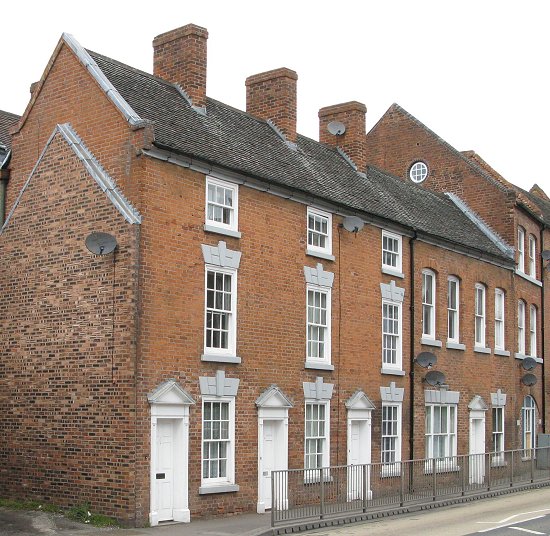 |
The row of houses in Lower
Rushall Street, Walsall. Once the site of Rushall Street
Works. |
|
According to Howard D. Clark in his
book ‘Walsall Past and Present’ published in 1905, the
firm exported large numbers of spectacles to many parts
of the world, but this part of the business was badly
affected by protective tariffs in various countries, and
so the firm diversified into gilding, electro-plating,
nickel plating, and buckle manufacturing.
The business still survives, and
now operates from F. H. Tomkins’ factory in Brockhurst
Crescent, Walsall.
The old workshops in Lower Walsall
Street were renovated in the 1990s and converted into
apartments.
The old courtyard and factory at
the rear is now called Eyland Grove, and is occupied by
apartments and a car park. |
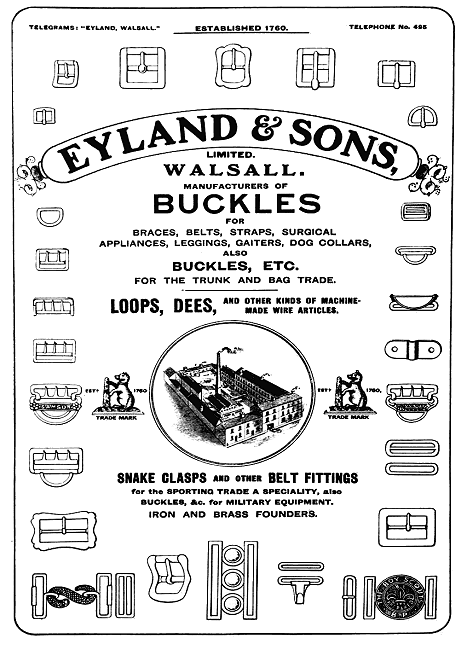
From the 1916 Walsall Chamber of
Commerce Year Book. |
|

From the 1958 Walsall County
Borough Directory. |
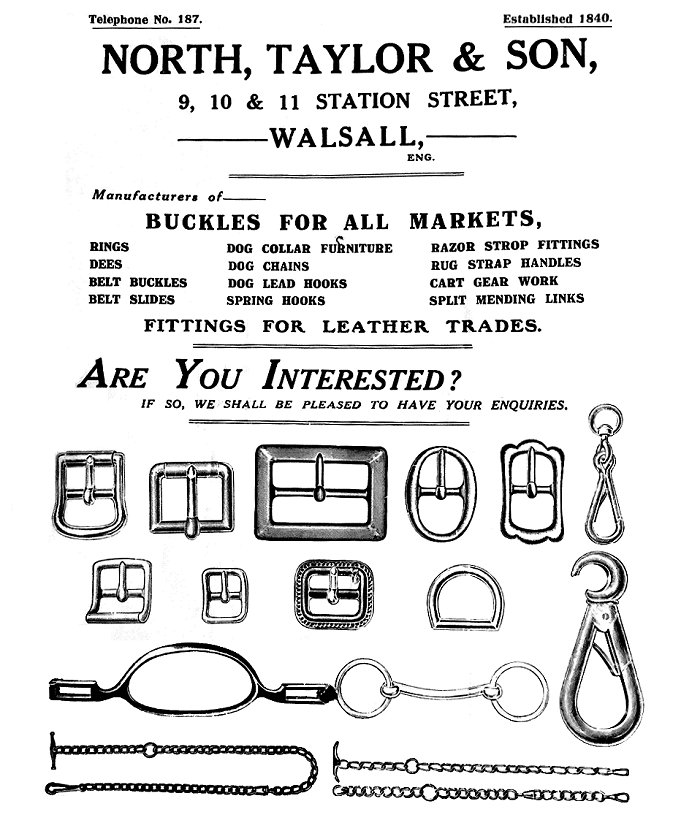
Heavy
IndustriesHeavy industry and
large scale manufacturing came to Walsall in the 19th
century thanks to the building of the Walsall branch of the
BCN, the Wyrley & Essington Canal, improvements to the
roads, and the advent of the railway.
The heaviest industry in the town was
iron-making, which developed due to improved transportation,
and copious supplies of local coal, iron ore, and Wenlock
Limestone, used as a flux in the smelting process. Walsall
like many other Black Country towns had several ironworks
and non ferrous metalworks.
|
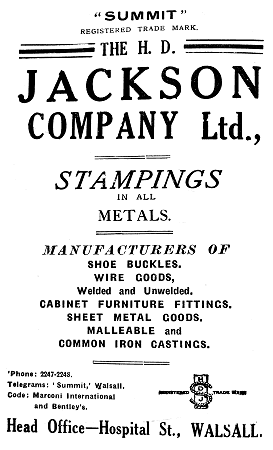
An advert from 1935. |
|
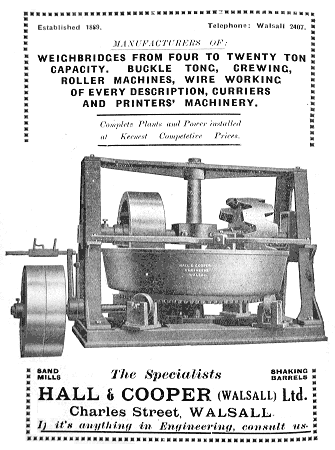
An advert from 1935. |
 |
Walsall's Ironworks and Metalworks |
 |
Foundries |
 |
T. Partridge & Company Limited. Structural
engineers |
 |
Johnson Brothers & Company Limited. Fencing,
railing, gates |
 |
Swallow Motorcycles |
 |
Swallow Sports Cars |
 |
Kirkpatrick Limited |
Other Industries
Chain making
In the middle of the
19th century, chain making was a significant industry in
Walsall, particularly chains associated with horses and
carts. As the demand for such chains fell in the 20th
century, the industry declined, but in the 1970s Walsall
still had five chain makers, 3 making harness and dog
chains, and two making chains for industrial
applications.
William White's
History, Gazetteer and Directory of Staffordshire
published in 1851 lists the following manufacturers:
|
Dog and Light Chains
Thomas Clark, Wisemore
Samuel Cooper Rycroft
George Griffiths, Stafford Street
Benjamin Harmes, Hammer Forge Lane
Joseph Kendall, Bank Street
Stephen Parker, Stafford Street
Thomas Reynolds, Stafford Street
Joseph Richardson, Wisemore
Joseph Russell, Ryecroft Street
James Shale, Stafford Street and Blue
Lane
Elijah Whitehouse, Stafford Street
Edward Wilkes, Lower Rushall Street
Cart Harness Chains
John
Adams, Birchills Lane
Thomas Boot, Lower Rushall Street
Davis Dewsbury, Wisemore
John Emery, Pool Street
Joseph Moseley, Church Street
Henry Shelley, Green Lane
Samuel Stephens, Ablewell Street
John Watkins, Nichols’ Yard
Edward Webster, Green Lane
Edward Wilkes, Lower Rushall Street
Curb Chains
William Barnett, New Street
John Beebee, Wisemore
William Bellingham, Upper Rushall Street
Joseph Butler, Stafford Street
Joseph Cooper, Stafford Street
Samuel Cooper, Ryecroft
Thomas Cooper, Ryecroft |
|
Curb Chains cont.
Daniel
Derby, Wisemore
George Evans, Thurstan’s Buildings
George Griffiths, Stafford Street
James Hale, Ablewell Street
Isaac Hanby, Lower Hall Lane
Charles Hanby, Hill Street
James Hawcroft, Caldmore
John Hickin, Bank Street
James Holden, Townend Bank
Joseph Lowbridge, Hammer Forge Lane
Joseph Lowbridge, Blue Lane
Thomas Mills & Son, Albert Street
Richard Morroll, St. Pauls Street
George Noke, Green Lane
John Osborne, Blue Lane
Samuel Osborne, Blue Lane
James Parker, Day Street
Stephen Parker, Stafford Street
Charles Reynolds, Stafford Street
Charles Ridding, Stafford Street
Edwin Roper, Hill Street
John Russell, St. Pauls Row
Joseph Russell, Ryecroft Street
Richard Shelley, Marsh Lane
Joseph Somerfield, New Street
Thomas Swan, Caldmore
Charles Webster, Caldmore
John Webster, Green Lane
John Webster, Marsh Lane
William Webster, George Street
Charles Whitehouse, Wolverhampton Street
Thomas Whitehouse, Marsh Lane
James Williams, St. Pauls Row
Simon Williams, Fieldgate |
|
By 1935 the number of
manufacturers had greatly reduced. The following list is
from the Walsall Red Book for that year:
|
Chain Makers
P.
Bull & Son, Margaret Street
W. J. Burns, 12 Carless Street
J. H. Carter, 16 Butts Road
J. A. Dewe, 72 Bath Street
O. D. Guest Limited, 51 Vicarage Street
J. H. Hawkins & Company, 16 Station
Street
J. T. Hyde, 1 Caldmore Road
H. D. Jackson Buckle Company Limited,
Hospital Street
F. Martin, Vicarage Place
S. Middleton, Back 18 Burleigh Street
H. Noakes, 77 Regent Street, Brownhills
T. Russell, 75 Regent Street, Brownhills
Stokes & Sons, Northcote Street
F. H. Tomkins Limited, 14 Caldmore Green
S. Venables & Son, 20 Shaw Street
Walsall Locks & Cart Gear Limited, Neale
Street
Job Wheway & Son Limited, Birchills
Chain Works, Green Lane |
|
|
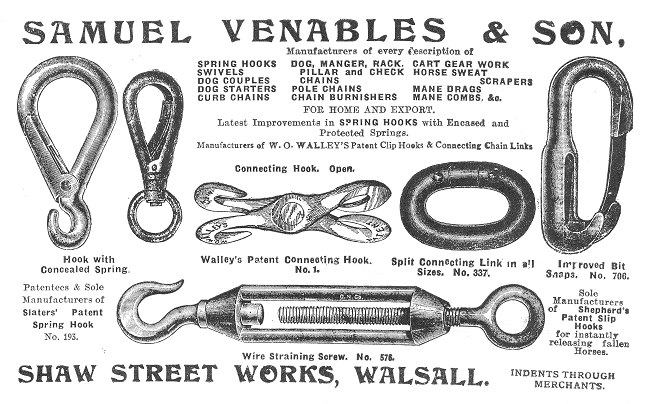
An advert from 1935.
|
Awl
blades
Awl blade manufacturing began in the
town in the late 18th century, and concentrated in the
Bloxwich area. Awl blades were a necessity in the leather
and saddlery trades until the introduction of stitching
machines which greatly reduced the demand. A few
manufacturers survived in the Bloxwich area, but by the mid
1970s only one still survived, Thomas Somerfield & Sons Limited,
Clarendon Street, Bloxwich.
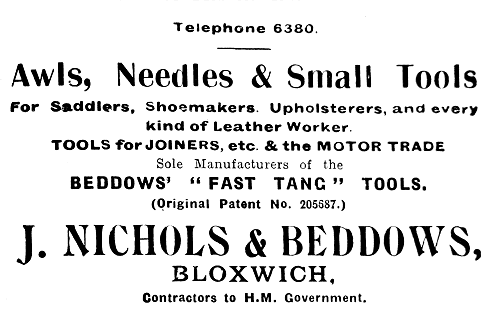
An advert from 1935.
William White's History, Gazetteer and
Directory of Staffordshire published in 1851 lists the
following manufacturers:
|
Walsall James
Ashwell, Caldmore
Emma Collins, Pleck
Clement Ross, Bradford Street
James Ross, Little London
Bloxwich
Charles Beech
Samuel Edge
George Evans
Henry Hackett
Charles Jones
Mark Nicholls
John Nicholls
Michael Parker
Michael Partridge
Thomas Partridge
John Reeves
Thomas Reeves
Isaiah Ross |
|
Bloxwich
cont. Thomas Ross
& Sons
Edward Russell
Thomas Somerfield
John Stokes
James Taylor
James Taylor junior
Daniel Wilkes
Thomas Woodall
Short
Heath
John Bullock
James Hodson
Mrs. Lebond
Henry Mason
Thomas Parker
Samuel Somerfield
William Somerfield
David Wilkes
Thomas Wood |
|
The manufacturers in 1935.
From the Walsall Red Book:
|
W. J. Goodwin & Son,
Burrowes Works, Wolverhampton Road
W. C. Harvey, 30 Bell Lane
E. Hill, 20 The Green, Bloxwich
John Nicholls & Beddows, Wallington Heath,
Bloxwich
J. Parker, 26 Marlborough Street
A. Ross & Company, 76 Sandwell Street
F. J. Ross & Sons, 140 Sandwell Street
Ross & Son, 501 Bloxwich Road
Somerfield & Sons, Clarendon Street
H. Vale & Sons, 18 Holtshill Lane |
|
|
|
Lock
Making
In the 19th century, Walsall had a
number of lock manufacturers, mainly specialising in cabinet
locks, and padlocks. In the 20th century the number fell.
Only four remained in the 1970s, and about the same
number remain today.
William White's History, Gazetteer and
Directory of Staffordshire published in 1851 lists the
following manufacturers:
|
Cabinet
Locks
James Archer, Prospect
Row
Charles Carless, Hill Street
William Duncomb, Blue Lane
John Lowe, George Street
William Marshall, Hammer Forge Lane
John Purchase, Blue Lane
Edward Rose, Caldmore
Mrs. Round, Birchills
Charles Tuckley, Birchills Lane
Windle and Blythe, King Street
Padlocks
Elias Ash, Stafford
Street
John Bates, Intown Row
John Bates, Whitehall |
|
Padlocks
cont.
James Hart,
Wolverhampton Road
Henry Johns, Garden Walk
Joseph Mills, Mountrath Street
Mills and Tibbits, Upper Hall Lane
Rim
Locks
Mrs. Webster, Adams Row
Trunk
Locks
Samuel Bayley, Station
Street
Stock
Locks
Stephen Yates, Brewer’s
Yard |
|
Manufacturers in 1935. From the Walsall
Red Book:
|
Ash & Rogers, Pargeter
Street
Bloxwich Lock & Stamping Company, Bell Lane,
Bloxwich
J. H. Goodman, 37 Harrison Street, Bloxwich
Hadley & Company, Mountrath Street
W. J. Heap & Son, 84 Lower Rushall Street
H. Johnson & Company, 150 Portland Street
D. Lycett, 45a Portland Street
Neville Bros & Company, Wednesbury Road
F. T. Sanders, 77 Field Road, Bloxwich
E. F. Sharpe, 14 Freer Street
A. E. Stych, 74 Pargeter Street
Walsall Locks & Cart Gear Limited, Neale
Street
A. Wilkes, Bloxwich Works, Bloxwich
O. Wilkes, 39 Cairns Street
Stephen Wilkes & Company, Pargeter Street
S. Wilkes & Sons Limited, Park Road,
Bloxwich |
|
|
|
Brush
Making
Brush making became an important
industry in Walsall in the late 19th century. It began in
the 1760s with just a handful of makers including Joseph
Nightingale, who had a workshop in Chapel Street; Hannah
Reynolds; George Reynolds, based in Church Street; and Simon Burrowes whose premises were in Rushall Street. James
Pigot’s Commercial Directory for 1818 lists the following
makers:
|
Thomas Brown, (bone and
ivory) Rushall Street
Joseph Buss & Company, ( bone) Dudley Street
John Groves, (wood) Stafford Street
Charles Hall, (wood and bone) Park Street
Thomas Mele, (bone) Rushall Street
Joseph Reynolds, (bone and ivory) Rushall
Street
Thomas Thornhill, Stafford Street |
|
The industry slowly grew. William White's History, Gazetteer and
Directory of Staffordshire published in 1851 lists the
following manufacturers:
|
John Adkins, Peal
Street
William Allen, Ablewell Street
David Clarke, Park Street
Joseph Cook, Bradford Street
James Eagles & Sons, Park Street
Maria Fletcher, Lower Rushall Street
Philip Holloway, Wisemore
Richard Thornhill & Sons, Bridge Street
William White, Stafford Street
Bone &
Ivory Brushes
Joseph Busst, Lower
Rushall Street
Joseph Busst junior, Stafford Street
George Jones, Park Street |
|
By the mid 1860s around 100 people
worked in the industry, making brushes of all kinds, ranging
from paint brushes, clothes brushes, and shoe brushes, to hair
brushes. In the latter part of the century the industry was
mechanised, and production vastly increased. Most of the
factories were near the town centre, but three were in
Bloxwich.
The number of manufacturers slowly
fell, and by 1921 only nine were left. The number continued
to fall to leave only three in the 1960s: Bradnack & Son at
Defiance Works in Birmingham Road, Busst & Marlow in Lower
Rushall Street, and Vale Brothers in Green Lane. In 1967 J.
Brierley & Sons Limited moved to Forest Works in Forest Lane
from Birmingham, to produce industrial brushes and personal
giftware.
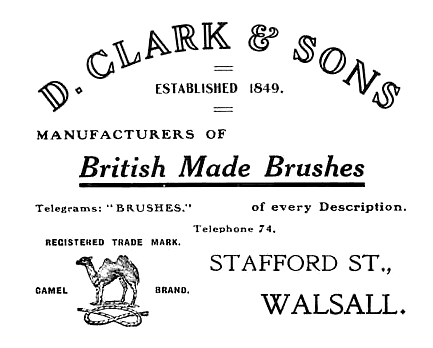
Busst & Marlow closed in the early
1970s, and Vale Brothers acquired Bradnack & Son, and moved
to Defiance Works to concentrate on production of grooming
brushes for animals. The company is now based in Long Street
and also makes horse-whips,
There was also the United Society of
Brushmakers, which met at The Prince in Delves Road. |
|
Manufacturers of Clothes
By the late 19th century Walsall was at
the centre of a large clothes manufacturing industry. The
best known manufacturer was Shannons, founded by Scottish
draper John Shannon, in 1826. In 1845 he opened a shop in
George Street, on land he leased from Lord Bradford, and in
1870 opened a workshop there. The business employed 20
people to make men’s clothing for the local market. He was
mayor of Walsall in 1850-51. After his death in 1875 he was
succeeded by his son Edmund John, who greatly expanded the
firm, mainly due to the recently invented sewing machine.
|
|
A Model Tailoring Factory.
From the Birmingham Daily Gazette, 11th May,
1888
Messrs. Shannon and
Sons, of Walsall, employ altogether 937
hands, 800 on the premises, 137 finishers
off the premises. They turn out in very busy
times 10,000 garments a week, and pay about
£800 in wages. The conditions that prevailed
during a visit paid yesterday, without a
minute's warning, may presumably be accepted
as normal conditions.
Every room was fairly
ventilated. Half the windows were open, half
the shafts and revolving fans and airbricks
and soon were blocked up as the result of
the workpeople's own carelessness. In one
room a girl thoughtlessly placed her shawl
and bonnet on the spout of an airshaft; in
another, a lad, finding the ventilating
chamber a handy receptacle for waist
material, stupidly filled it up. But no
system can stop such blunders as these.
In the largest room,
where 200 women and girls were employed,
complaint was made that there was too much
air. There were no draughts, but the
powerful ventilators in the V-shaped roof
sucked up all the foul air and made the room
cool. Gas-heated pressing irons are in use,
and to minimise the heat, experiments are
being made with escape flues, which are
intended to carry off the air fouled by the
gas burnt. The electric light has been
recently installed, and now every workshop
is fitted with arc lamps.
The pressing room is
the only room uncomfortably warm, night or
day, and it is proposed shortly to transfer
the ironers to a larger, loftier, and better
arranged gallery, with specially contrived
flues and fans to carry off the hot air.
Captain Bevan, the Walsall Inspector of
Factories, has no improvements to suggest,
the employees have no blame even for one's
private ear.
The books show that
fair wages are being earned. Last week the
men, women, and children were exceptionally
busy, and they will remain busy for two or
three weeks so the wages paid last Saturday
would be somewhat misleading. A glance at
the average for a year is more interesting
and instructive. There are 300 machines at
work, managed by girls ranging from 14 to 25
years of age. These earned last year -
according to age and ability - 9s.4d.,
12s.6d., 16s.3d., 7s.10½d., 8s.9d., 10s.8d.,
17s.1d., 5s.3d., 16s.ld. These are figures
taken haphazard from hundreds of ledger
entries.
Girls are generally
engaged at 13 or 14 years, and earn little
for two years; then, according to whether
they are clever or stupid, they carry home
from 7s. - 12s. a week; if they remain
unmarried at 21, they can earn 18s. or 20s.
in busy times and 15s. a week all the year
round.
Juvenile's clothing is
sold now at exceedingly cheap rates. A boy
of eight years can be rigged out in quite a
dainty costume for 3s. 3d. - jacket, blouse
and knickerbockers. Yet in the making of
these inexpensive suits, girls average
8s.ld., 7s.l0d., 9s.4d., and 13s.8d. a week,
and averaged a little less for the year.
Coat machinists who must possess more skill,
earned last week - 12s.9d., £1.3s.9d.,
8s.10d., and £3 a week, and averaged a
little less for the year. Vest machinists do
not earn quite so much; trousers baisters
can gain from 12s.11d., to 23s.6d., per
week; coat and vest buttonhole makers from
6s.10d., to 18s.8d.; coat pressers were paid
from £1.7s. to £1.16s; trouser pressers were
paid as much as £2.10s. (an average week
would represent about 30s.) These wages are
earned by working ordinary hours - eight to
eight. The clean, neat clothes and bright
faces of the people indicate that the only
sweating they experience is that required by
any diligence in any manual trade. |
|
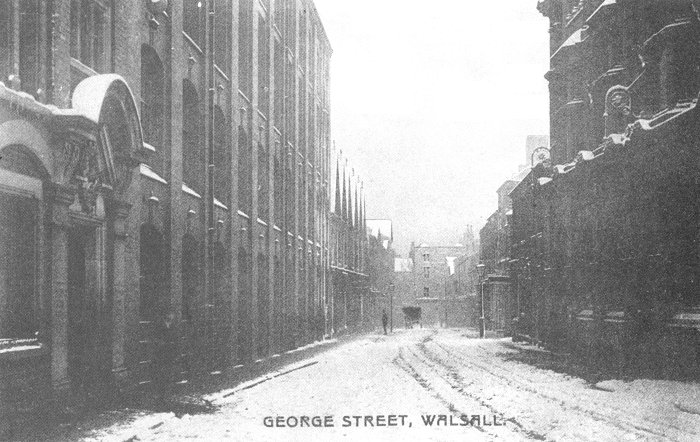
A wintry view of George Street, with
Shannon's Mill on the left. From an old postcard.
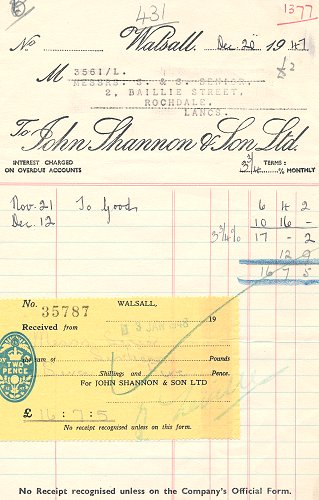 |
By 1887 the workshop had become too
small and so the impressive four storey Shannon’s Mill was
built. The brick building was in three parts, two of eight
and eleven bays, and a central part with eight bays and
elaborate stone stringing.
Around 1890 the firm became John
Shannon & Son Limited, and at the turn of the century the
building was greatly extended. By 1905 Shannons employed
over 2,000 people, mainly 14 to 25 year old girls who
operated the 300 or so machines. The girls started work at
the age of 13 or 14 and were not paid at all for the first
two years. Before they were paid they had to learn all
aspects of the trade and assisted other workers. After two
years they could earn between 7 shillings and 12 shillings a
week.
Shannon’s products included wholesale
clothing manufacture, and high quality ready to wear men’s
and boy’s suits, and ladies’ costumes. In 1913 Edmund
Shannon was succeeded by his son John C. Shannon.
After the First World War there was a
depression in the trade, which in 1926 resulted in the
resignation of John Shannon, and the company going into
liquidation. The company managed to survive, and went public
to become John Shannon & Sons Limited with the Shannon
family as major shareholders.
|
| |
|
Read a description of a
visit to Shannons in 1897 |
 |
| |
|
|
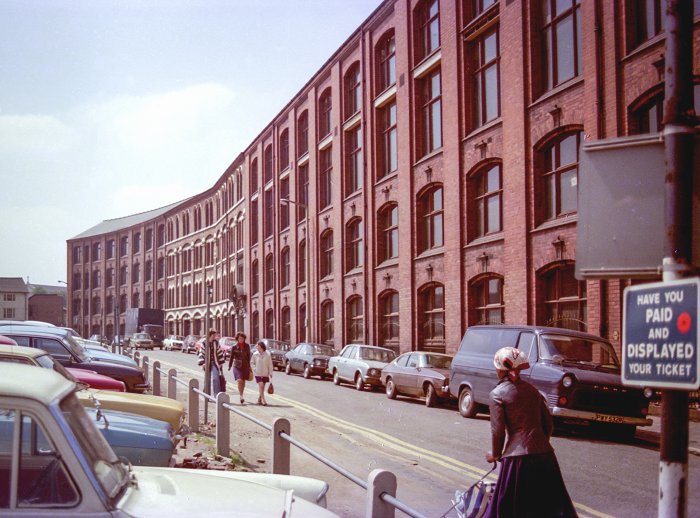
Shannon's Mill from 1977.
Courtesy of Paul
Bowman. |
|
During World War 2 Shannons produced
large numbers of military uniforms and the future looked
bright. After the war rates of pay slowly increased, and as
Shannons were unable to pay higher wages, the number of
employees fell, and the company reduced in size.
In 1973 Shannons still occupied the massive old works, and so the
decision was taken to let parts of the building to other
companies, including part of the Walsall leather goods firm
W. A. Goold (Holdings), the saddlery firm E. Jeffries &
Sons, the jewellery division of Pearmak, and Leonard Neasham,
the gentleman's outfitters.
Shannons ceased trading in 2000 and the building remained
empty for several years. It was due to be the centrepiece of
a £53m regeneration project for St Matthew's Quarter, but on
Friday 3rd of August, 2007 the mill suffered badly from a
mindless arson attack.
The building was badly damaged, 60
percent of it collapsed. It had been the largest fire in the
town for 25 years. By the end of the month the dangerously
unsafe building had been demolished. A sad end to such a
wonderful local landmark.
|
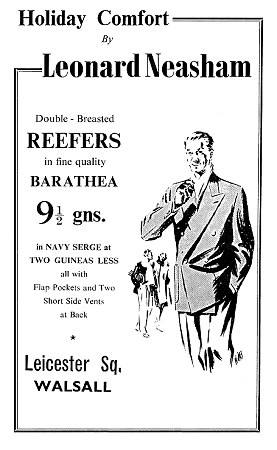
An advert from 1953. |
|
Another clothing manufacturer, Stammers
was founded in 1904. The firm was initially based in Dudley
Street, but in 1906 moved to New Street after becoming a
subsidiary of the Foster Bros. Clothing Company Limited of
Birmingham. The factory was extended around 1925 and
specialised in men's and boys' clothing.
The 1935 Walsall Red Book lists the
following manufacturers:
|
Mark Cohen & Company, 2
Whittimere Street
T. Bednall & Company, Mountrath Street
Bradbury & Company, Teddesley Street
Harris Davis (Walsall) Limited, Adams Row
Hayward & Jones, 41 Station Street
Marshall & Hamblet, Littleton Street
Norton & Proffitt, Midland Road
Parkinson (Walsall) Limited, Chuckery Road
J. Shannon & Son Limited, George Street
Stammers Limited, New Street |
|
There were ten clothing manufacturers
in1963, but only six by 1973. |
| Electrical Engineering
One of Walsall’s most famous manufacturers was J. A.
Crabtree & Company Limited based at Lincoln Works in Beacon
Street.
The business was founded by John
Ashworth Crabtree who was born in Broughton, Lancashire,
just north of Preston on October 24th, 1886. His father died
when he was just five years old, and his mother and her
family moved to Yardley in Birmingham. John’s career began
as an engineering apprentice.
|
| He initially worked for Verity's Limited, electrical
manufacturers based at Aston in Birmingham, and then moved
to J. H. Tucker Limited, manufacturers of switchgear in Tyseley, Birmingham. After working in Tucker’s workshops, he
moved to the drawing office, and whilst there invented, and
patented an improved type of switch. John decided to start
his own business, to manufacture the patented quick make
and brake switch, after Tuckers refused to do so.
In 1919 he
founded J. A. Crabtree & Company in a small disused leather
works in Upper Rushall Street, Walsall. The switch became a
great success, orders poured-in, and the company soon
outgrew the small factory.
In 1923 the firm acquired seven acres
of land in the Chuckery, alongside Beacon Street and Lincoln
Road, where a new factory called Lincoln Works was built. |
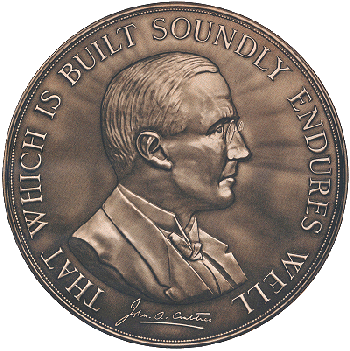
John Ashworth Crabtree. |
|
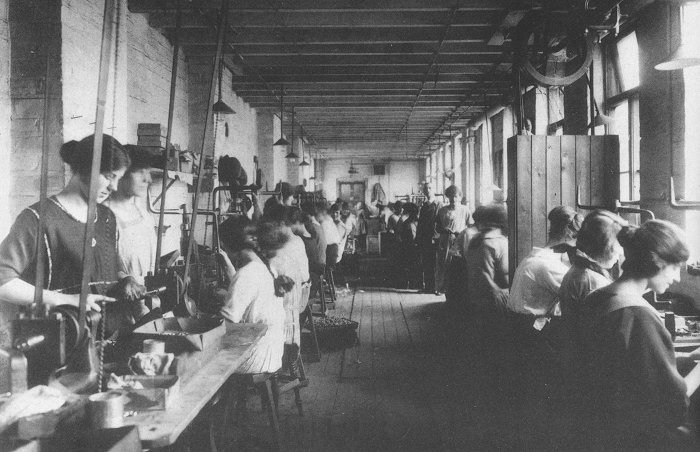
One of the workshops in Upper
Rushall Street. |
|
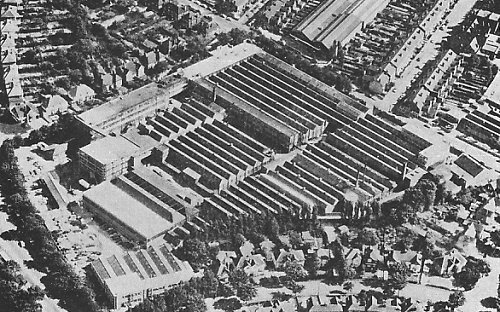
Lincoln Works. From the 1974 Walsall
Handbook. |
It
was named after President Lincoln who John greatly admired.
By 1926 around 600 people were employed on the site. The
business prospered, and in 1929 John Crabtree developed the
first plastic moulded switch which he called ‘The Lincoln
Switch’.
The plastic that he developed was called ‘Jacelite’
to distinguish it from bakelite. |
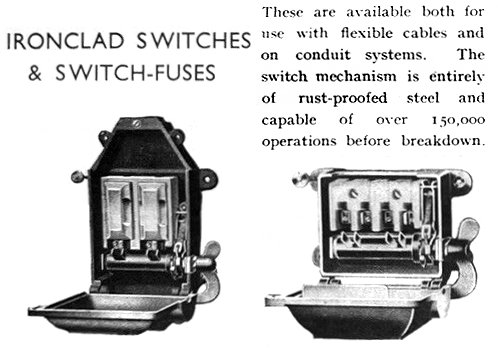 |
An advert from 1935. |
| An advert from 1935. |
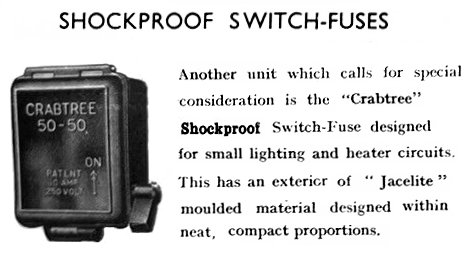 |
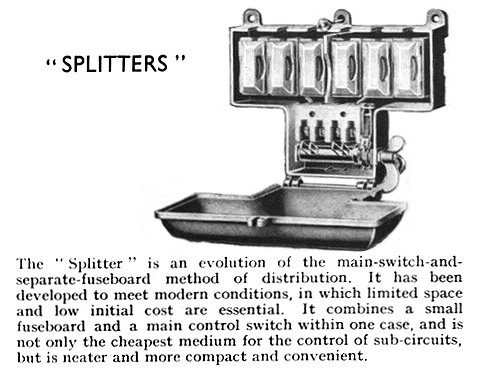 |
An advert from 1935. |
| An advert from
1935. |
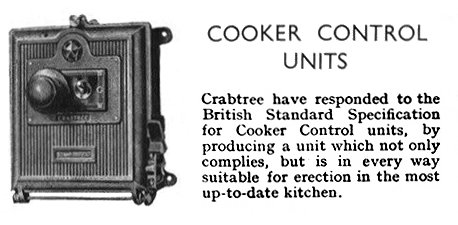 |
|
By the early 1930s Lincoln Works had
grown into the best equipped factory of its kind in the
country, and employed around 1,000 people.
In the autumn of
1935 John went to America on a business trip, and caught
pneumonia, from which he died on November 27th, at the age
of 49.
After John’s death, his widow took a
leading role in the company, and in 1944 her son Jack joined
the Board after graduating from Queen’s College, Oxford. He
became Chairman and Managing Director in 1958.
| |
|
|
|

View pages from
the staff magazine |
|

View some of the
company's products |
|
|
|
|
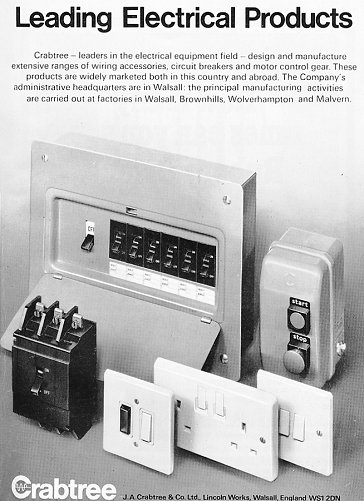
An advert from 1974. |
| |
|
| Read about Crabtree in the
late 1940s |
 |
| |
|
|
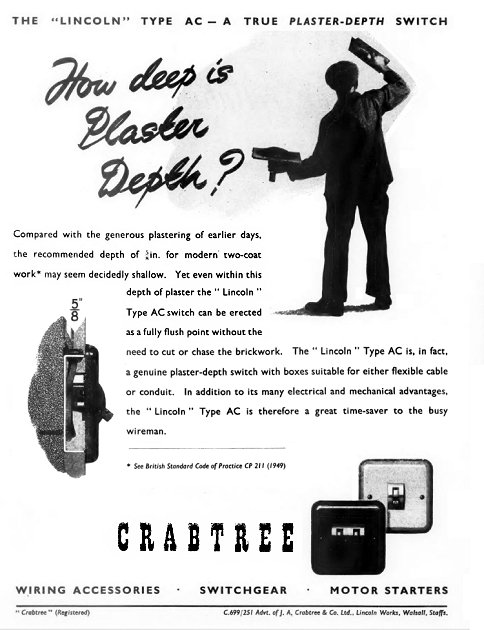
An advert from November 1954. |
Two new Crabtree products featured in an article in 'The
Engineer', 15th April, 1960.
| The new C-50 miniature
circuit-breakers are designed to
challenge the use of rewirable fuses
for sub-circuit protection. As such
they can be fitted in what is
claimed to be the first all
insulated consumer unit to give
circuit-breaker protection to the
sub-circuits. The C-50 circuit
breaker has an electromagnetically
operated tripping mechanism, all
ratings being set to trip on a
sustained overload of 30 percent.
"Nuisance" tripping by harmless
transient overloads is prevented by
a built-in inverse time-current
delay device.
It will be seen from the
photograph that the operating handle
controls the moving contact through
a collapsible over-centre toggle
mechanism. Since the handle is in
positive control in the "On" and
"Off" positions, the breaker can
always be opened or closed manually.
The moving contact traverses the
'V' shaped slots in a series of arc
grid plates at the top of the switch
and is shown in the closed position.
The overload coil and time delay
device are located in the bottom of
the moulded case of the circuit
breaker. |
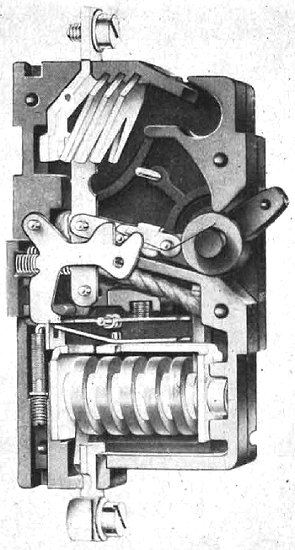
Miniature circuit breaker (C-50)
set to trip on 30 percent overload,
and fitted with inverse time delay. |
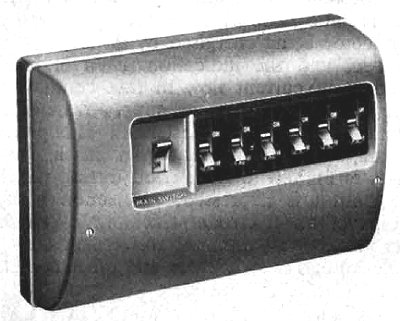
The All-insulated consumer unit
enclosing a 60A double-pole
isolating switch and six miniature
circuit breakers, of ratings from
2.5A to 50A. |
The fully-insulated consumer
unit consists of a moulded cover in
a silver-grey colour, enclosing a
60A double-pole isolating switch and
up to six miniature
circuit-breakers, which can be of
various ratings, from 2.5A to 50A. |
|
|
|
|
In 1961 the company launched the UK’s
first circuit breaker, and continued to produce vast numbers
of plugs, sockets, switches, and motor control gear. By the
late 1960s the workforce had grown to over 3,000.
|
| |
|
| View some images, and the
programme from the Queen's visit to Lincoln Works in May
1962 |
 |
| |
|
| In 1972
the company was acquired by Ever Ready, and after a
succession of owners, Lincoln Works closed in 1997 and
production was moved elsewhere. Crabtree became the largest
private employer in Walsall, so the closure came as a great
blow to the town. |
|
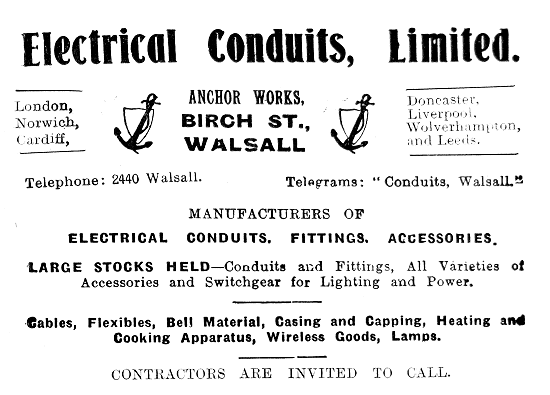
An advert from 1935.
The earliest electrical engineering
company in the town was possibly the Walsall Electrical
Company founded in 1884 by Frederick Brown to
make bells, electrical fittings, fuses, indicators, lamps,
and switches. It had an office at 57 Bridge Street, a
factory at the rear of 57, 59, 61 and 63 Bridge Street, and
became a limited company on the 2nd December 1892. There
were three directors; Frederick Brown the Managing Director
and major share holder, John Hildick the Chairman, and Henry Nicklin. There was also an office in Birmingham.
The Managing Director's salary was £350
per year, plus 25 percent of the profits. The authorised
capital of the company was £10,000 in £10 shares. Brown
applied for, but did not always register the patents for the
numerous electrical instruments and appliances that he
developed, including advertising signs, galvanometers,
lamps, medical induction coils, switches, and voltmeters.
Frederick Brown was born in Pensnett in
March 1848. He was a member of an old Quaker family, and
educated at the Friends School, Ackworth in Yorkshire. He
began his career as a photographer with a Mr. Draycott at
their premises at The Bridge. In 1881 he became manager of
the National Telephone Company, and left in 1884 to set up
the Walsall Electric Company.
|
|
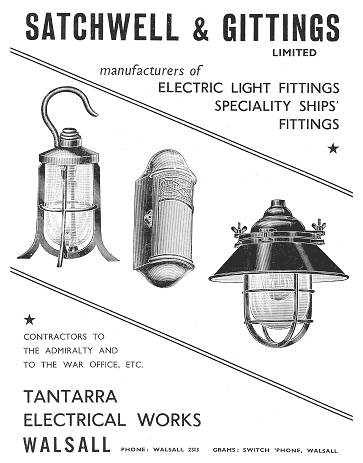
An advert from 1954. |
In 1891 he became an electrical
engineering consultant to Walsall Council to advise on the
method of power transmission to be used by the South
Staffordshire Tramways. After a fact-finding trip to
America, he submitted his report in July 1891, and was later
appointed to supervise the installation of the overhead
cabling for the trams.
In February 1893 Brown was appointed by
the council to advise on their electric lighting scheme. He
became a leading member of Walsall Chamber of Commerce, and
was President in 1910 and 1911.
By 1901 the firm had appointed agents
in London and Liverpool, and after making an initial loss
became profitable. John Hildick resigned from the Board in
November 1908, and was replaced as Chairman by Henry Nicklin.
At the same time a new director, James Osmonde Dale was
appointed.
Frederick Brown died on 8th August, 1913
at Streetly. He was replaced by F. Bailey.
|
| The early 1930s was a bad time for
the company which was not profitable. It became Walsall
Instrument Limited, on 10th August, 1932, and produced
switchboard instrumentation, charging apparatus and
regulators at Faraday Works, Algernon Street, Walsall.
Sadly things did not improve and the business went into
creditor's voluntary liquidation on 26th April, 1933. The company managed to survive, and
changed its name back to the Walsall Electrical Company
Limited. The product range was extended to include crane
plug boxes. The business again became profitable, employing
around 50 people.
| View some of the
company's products from the 1947 and 1961 catalogues |
 |
In 1949 the company registered the 'WALTRIC'
trade mark, but unfortunately the firm failed to invest in
research and development, and so the products became
outdated as technology changed. The products in the 1947
catalogue appear to be from the early 1930s rather than the
late 1940s. In 1983 the firm took out a
medium term loan to finance the development of a range of
panel meters, which were quite successful. In 1992 the
business merged with Beacon Instruments Limited to provide a
wider product range, but suffered from increased competition
from cheaper products made in the Far East and India. In
2002 the business was put up for sale, but little interest
was shown, and it closed in 2004.
There were several other electrical
manufacturing companies in Walsall including Bayley Bros.,
the Central Manufacturing Company, The Mechanical &
Electrical Engineering Company (Walsall) Limited, and Electronics Design
Associates.
|
| |
|
| Read about the Mechanical &
Electrical Engineering Company (Walsall) Limited |
 |
| |
|
|
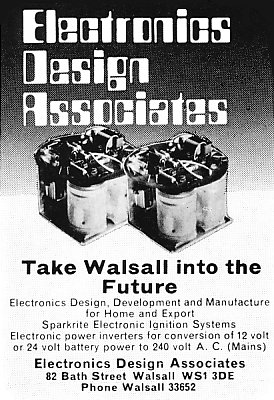
An advert from 1976.
Other
Locally Made Products
|
|
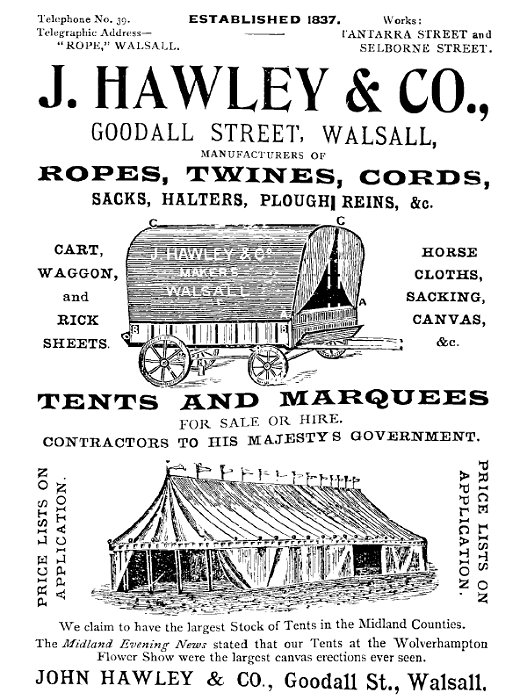
An advert from 1902. |
Packing cases and cardboard boxes have
been made in Walsall since the 19th century. In 1834 packing
cases were being made by James Rooker Mason in High Street,
and Mary Silleter in the Square.
In 1935 they were produced
by T. Ginder & Son Limited of Whittimere Street, and
Bradford Street; and John York of 19 Goodall Street.
In 1935 cardboard boxes were produced
by Mrs. F. Burton, 33 Hart Street; B. Fenton, Midland Road;
G. Parsons & Company, Back 33 Station Street; A. Platt, 115
Bridgeman Street; and The Walsall Box Company in Bank
Street.
Other products included India rubber
goods, rubber stamps, rope and twine, riddles and sieves,
and plastic mouldings, which were produced by E. Perkins &
Company Limited in Selborne Street, and the Plastics
Products Company in Midland Road. |
| In the late 19th century and early 20th century,
many bicycles were made on a small scale in most of the
local towns, often at the back of a shop. The industry
relied on locally made cycle accessories, many from
Birmingham, and locally made tube for the frame. There
were at least five manufacturers in Walsall: J. E. Wheway, builder of 'Cyverite'
cycles; the Vanguard Cycle Company Limited, manufacturer
of 'Vanguard' cycles, Ford & Butler, 15 Bradford Street;
John More & Company, Highgate Cycle Works, Sandwell
Street, manufacturer of 'Highgate' cycles; and Harry
Lester of 25 Bradford Street. |
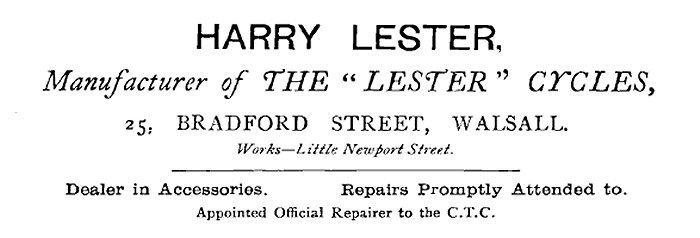
An advert from 1902.
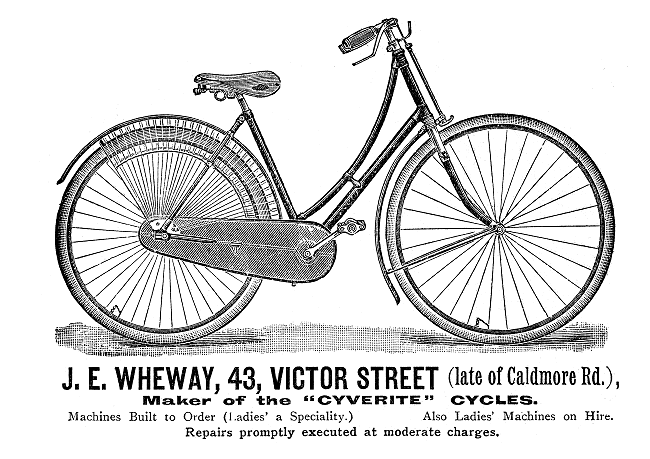
An advert from 1899.
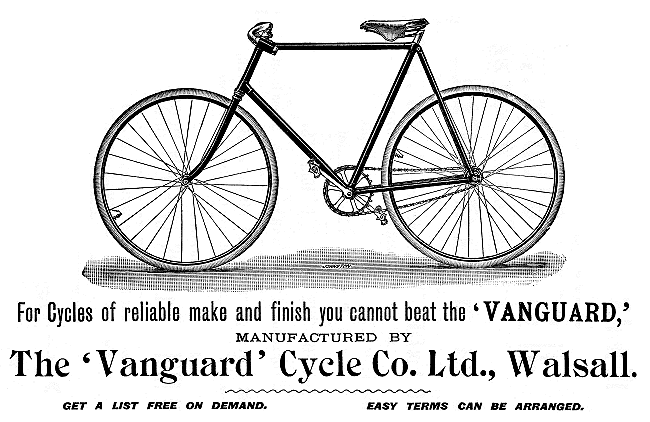
An advert from 1899.
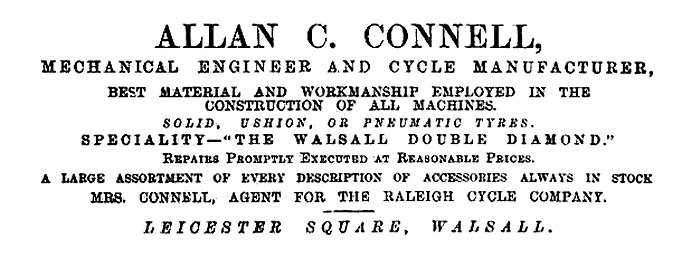
An advert from 1892.
| An advert from 1958. |
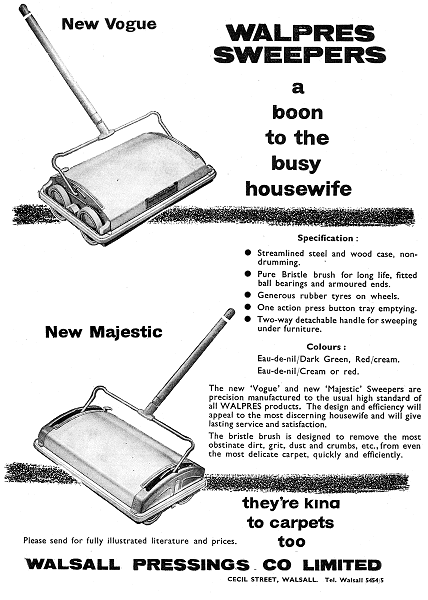 |
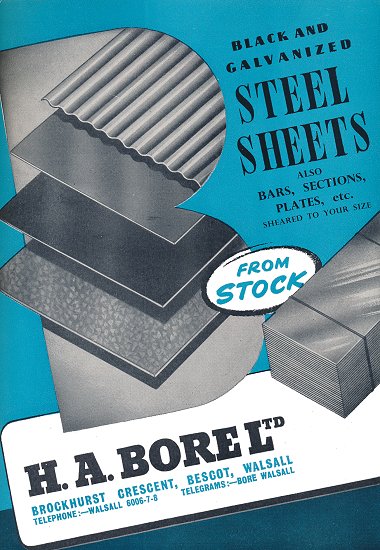 |
An advert from 1958. |
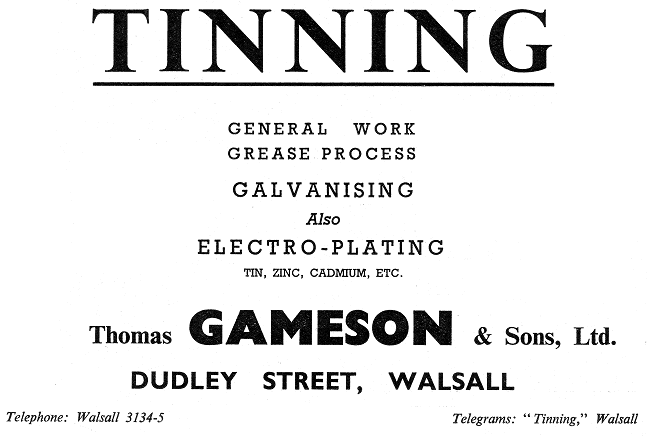
An advert from 1958.
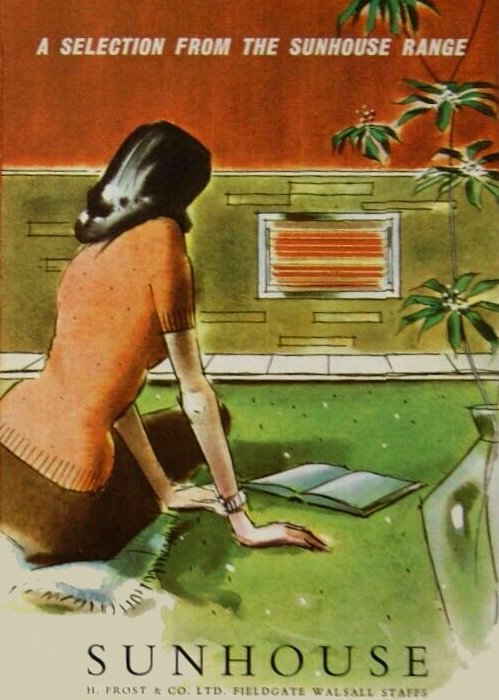
An advert from the 1960s.
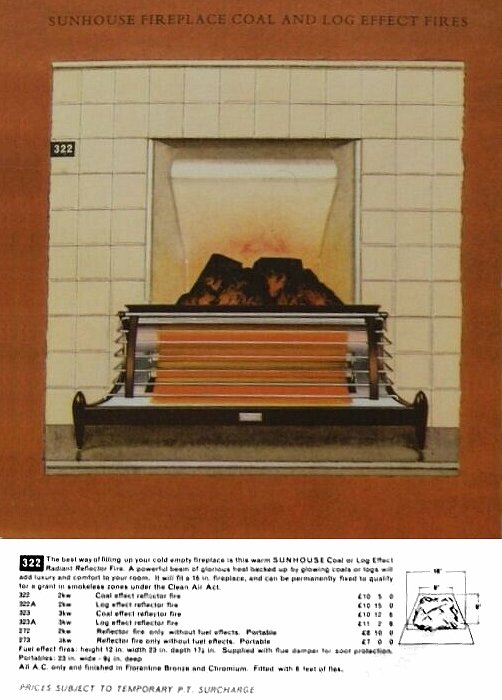
An advert from the 1960s.
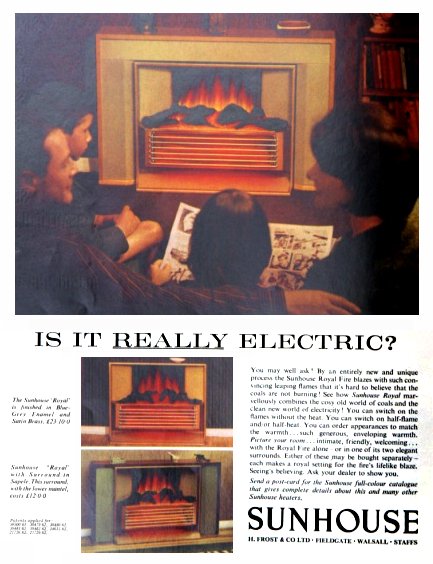
An advert from the 1960s.
 |
|
 |
|
 |
Return to Into
The 19th Century |
|
Return to
the beginning |
|
Proceed
to Late 19th Century |
|